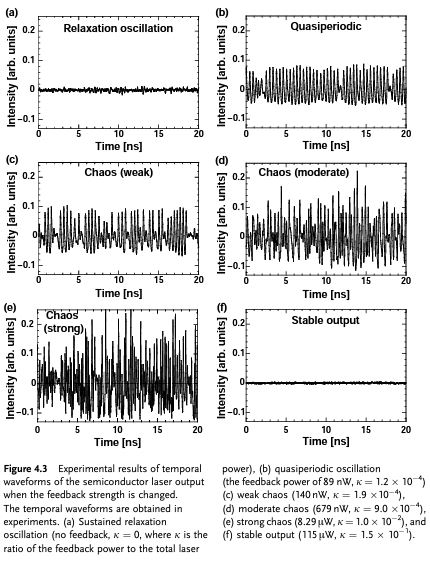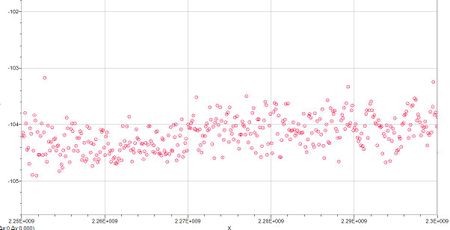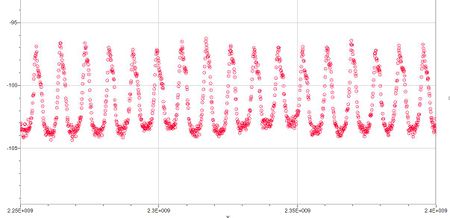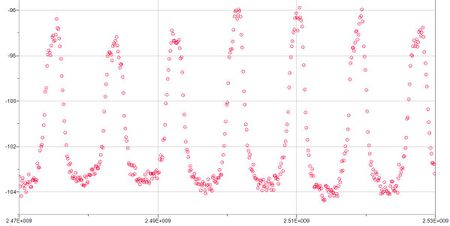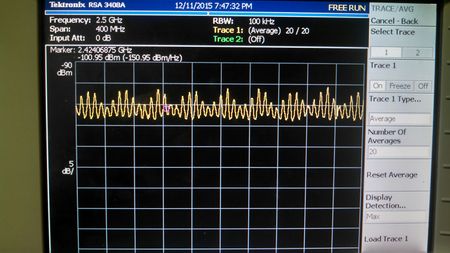Difference between revisions of "Optical Chaos with External Feedback Mirror"
Aplstudent (talk | contribs) (→Expected Results) |
Aplstudent (talk | contribs) (→Results) |
||
| Line 71: | Line 71: | ||
[[File:Modchaos.jpg|450px]] | [[File:Modchaos.jpg|450px]] | ||
| − | Unfortunately, there were some complicating issues that make me wonder if I actually achieved chaos. From the plotted results of 317uW, you can easily see the sharp tiny peaks of high chaos begin to form, as the power level drops. This is basically the effect of returning too much light into the laser cavity: instead of complicating things as it does at low feedback levels, it entirely wipes out the dynamics, and stabilizes the power. | + | Unfortunately, there were some complicating issues that make me wonder if I actually achieved chaos. From the 15uW frequency plot, you can see peaks spaced 10MHz apart. This indicates a cavity, which matches the calculated external feedback frequency for it. |
| + | |||
| + | |||
| + | |||
| + | From the plotted results of 317uW, you can easily see the sharp tiny peaks of high chaos begin to form, as the power level drops. This is basically the effect of returning too much light into the laser cavity: instead of complicating things as it does at low feedback levels, it entirely wipes out the dynamics, and stabilizes the power. | ||
Revision as of 14:47, 14 December 2015
Background
Lasers have useful applications in our lives as clean, coherent light sources. However, lasers are not perfectly stable, and by feeding light back into the laser, one can create an unstable output. Manipulating the level of feedback, along with other variables, it has been shown that one can create “optical chaos”, or highly irregular and complex behavior in the power output. By nature, a chaotic system has an unpredictable output and is sensitive to slight changes in initial conditions. The output may at first seem random and disordered in strength, but it is really just complex behavior controlled by a deterministic rule (the Lang-Kobayashi equations).
Although it is difficult to find the usefulness of optical chaos in everyday life, with some ingenuity it has led to applications in optical communication security and random number generation. This experiment will only seek to prove that chaotic laser systems exist, and will not discuss synchronization in optical chaos (the idea that dual lasers can be "locked" in the same pattern") or verify any communication practically.
Setup
As you can imagine, there are several ways to feed light back into the laser cavity. (You may have even done so without noticing!). Here are a few configurations:
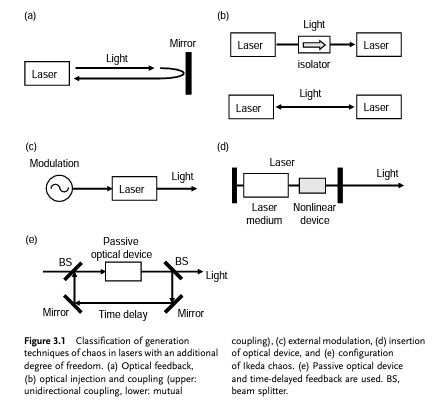
We will use Configuration A, directing laser light through a Fiber Coupler (a beamsplitter for a fiber), into a retroreflector (mirror), and returning it back to the source. This path has a Variable Optical Attenuator (VOA) on it, to control the amount of feedback power. Then, we can look at the chaotic light from the second path by measuring with an ultrafast Photodiode connected sometimes to an Oscilloscope and sometimes an RF Spectrum Analyzer. This second path has a Fiber Isolator (F-ISO) on it, to protect against unwanted back-reflection between the FC and the PD (we don't want it here, because we're still trying to measure the effect of the first cavity!).
A Diagram of the Setup is here:
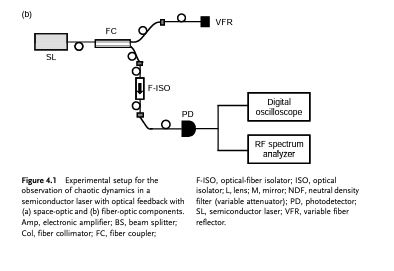
Goals
Set-up a valid semiconductor laser (FC 1550nm class B) experiment to induce optical chaos.
• Prove the existence of optical chaos with experimental results • Get Power output on oscilloscope • RF spectra
• Observe chaotic behavior in a few regions of instability
Expected Results
Frequency Spectrum (on RF SPECTRUM ANALYZER)
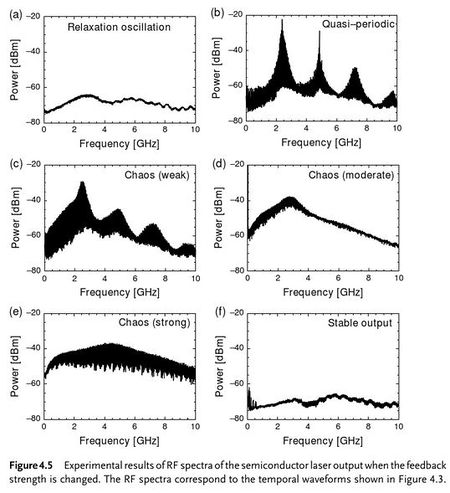
And, distinguishing between the Pattern of Chaos vs stochastic noise from the Sustained Relaxation Oscillation:
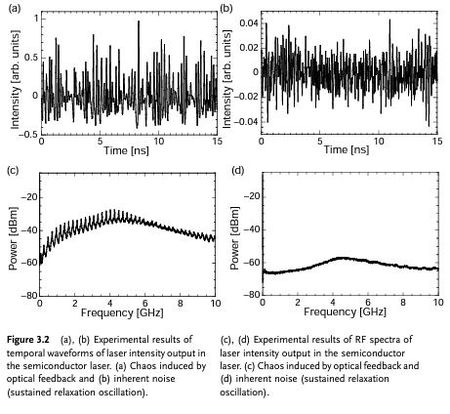
Results
I decided to test my laser set-up in couple of different regimes:
ON RF: sampled background signal, 100nW, 300nW, 500nW, 1uW, 5uW, 10 uW, 15uW, 20uW, 30uW, 40uW, 50uW, 55uW. Anything beyond this threatened the operable range of the VOA. Was able to sample at 317uW by cranking the input power and adding a 5dB fiber attentuator to the face of the PD.
Units of the graph:
X-axis is Frequency domain in Herz. (In the range of 2.25GHz - 2.4GHz) Y-axis is Power Output Level, measured in dBm. (In the range of -100dBm)
This is what the data looks like on the scope. This is for a feedback level of 55uW, which was the highest that the VOA could run at, but still not enough to make strong chaos.
Unfortunately, there were some complicating issues that make me wonder if I actually achieved chaos. From the 15uW frequency plot, you can see peaks spaced 10MHz apart. This indicates a cavity, which matches the calculated external feedback frequency for it.
From the plotted results of 317uW, you can easily see the sharp tiny peaks of high chaos begin to form, as the power level drops. This is basically the effect of returning too much light into the laser cavity: instead of complicating things as it does at low feedback levels, it entirely wipes out the dynamics, and stabilizes the power.



